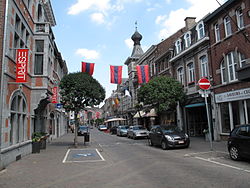Visé
Visé
Wezet (Dutch) | |
|---|---|
 | |
| Coordinates: 50°44′N 05°42′E / 50.733°N 5.700°E | |
| Country | |
| Community | French Community |
| Region | Wallonia |
| Province | Liège |
| Arrondissement | Liège |
| Government | |
| • Mayor | Viviane Dessart (MR) |
| • Governing party/ies | MR - PS |
| Area | |
| • Total | 27.73 km2 (10.71 sq mi) |
| Population (2018-01-01)[1] | |
| • Total | 17,767 |
| • Density | 640/km2 (1,700/sq mi) |
| Postal codes | 4600-4602 |
| NIS code | 62108 |
| Area codes | 04 |
| Website | www.vise.be |
Visé (French pronunciation: [vi.ze]; Template:Lang-nl, Dutch pronunciation: [ˈʋeːzɛt]) is a municipality and city of Belgium, where it is located on the river Meuse, in the Walloon province of Liège.
The municipality consists of the former municipalities of Visé, Lanaye (Ternaaien), Lixhe (Lieze), Richelle, Argenteau, and Cheratte.
In the north-east (on the eastern bank of the Meuse river) the area of the municipality extends up to the village of Moelingen in the Limburgian municipality of Voeren, while in the north-west (on the western bank of the Meuse river) it extends up to the border between Belgium and the Netherlands (on the other side of which the Dutch municipality of Maastricht is situated).
The city of Visé is located in a distance of some 20 km (12,4 miles) north eastern of Belgian Liège city and of some 15 km (9,3 miles) southern of the most southern Dutch city of Maastricht.
Apart from the Meuse river another waterway, the Albert Canal, passes through this town.
History
The Germans entered Belgium on 4 August 1914, and entered Visé that day as part of the opening movements of the Battle of Liège. A small group of Belgian gendarmes opposed the advancing Germans and two of their number, Auguste Bouko and Jean-Pierre Thill, were killed in the action becoming the first Belgian casualties of World War I.[2] On 7 August, in the Lixhe section of the town, the German 90th Infantry Regiment killed eleven civilians and destroyed eleven houses.
The Lixhe part of the town was also the site of one of Belgium's ninety eastern-frontier advanced-warning posts (postes d'alerte de la frontière est), aimed at preventing a German invasion in 1939 - its number was "PA 0". The coal mine of Hasard de Cheratte was dug in Cheratte and exploited between 1850 and 1977.
Gallery
-
Visé town hall
-
Saroléa castle at Cheratte
-
City view from westbank of the Meuse river
-
Albert Canal at Lanaye
See also
References
- ^ "Wettelijke Bevolking per gemeente op 1 januari 2018". Statbel. Retrieved 9 March 2019.
- ^ Poelmans, Marc. "Les gendarmes Auguste Bouko et Jean-Pierre Thill, premiers héros belges de 1914". www.arquebusiers.be. Archived from the original on 30 August 2018. Retrieved 18 April 2018.
External links
 Media related to Visé at Wikimedia Commons
Media related to Visé at Wikimedia Commons










